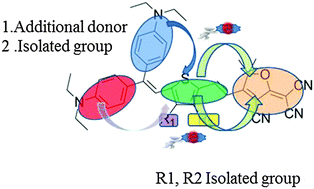The synthesis of new double-donor chromophores with excellent electro-optic activity by introducing modified bridges
Abstract
A series of chromophores y1–y3 based on the same bis(N,N-diethyl)aniline donor and the tricyanofuran acceptor (TCF) linked together via the modified thiophene π-conjugation with different isolated groups have been synthesized and systematically investigated in this paper. Density functional theory (DFT) was used to calculate the HOMO–LUMO energy gaps and first-order hyperpolarizability (β) of these chromophores. Besides, to determine the redox properties of these chromophores, cyclic voltammetry (CV) experiments were performed. After introducing the isolation group into the thiophene, reduced energy gaps of 1.03 and 1.02 eV were obtained for chromophores y2 and y3, respectively, much lower compared to chromophore y1 (ΔE = 1.13 eV). These chromophores showed better thermal stability with their decomposition temperatures all above 220 °C. Besides, compared with results obtained from the chromophore (y1) without the isolated group, these new chromophores show better intramolecular charge-transfer (ICT) absorption. Most importantly, the high molecular hyperpolarizability (β) of these chromophores can be effectively translated into large electro-optic (EO) coefficients (r33) in poled polymers. The electro-optic coefficient of poled films containing 25% wt of these new chromophores doped in amorphous polycarbonate (APC) afforded values of 149, 139 and 125 pm V−1 at 1310 nm for chromophores y1–y3, respectively. Besides, when the concentration was increased, the film containing chromophores y1 and y3 showed obvious phase separation, while the film with chromophore y2 showed the maximum r33 value of 146 pm V−1. Moreover, the electro-optic film prepared with these new chromophores showed greater stability. High r33 values indicated that the double donors of the bis(N,N-diethyl)aniline unit can efficiently improve the electron-donating ability and the isolated groups on the thiophene bridge can reduce intermolecular electrostatic interactions, thus enhancing the macroscopic EO activity. These properties, together with the good solubility, suggest the potential use of these new chromophores as advanced material devices.


 Please wait while we load your content...
Please wait while we load your content...